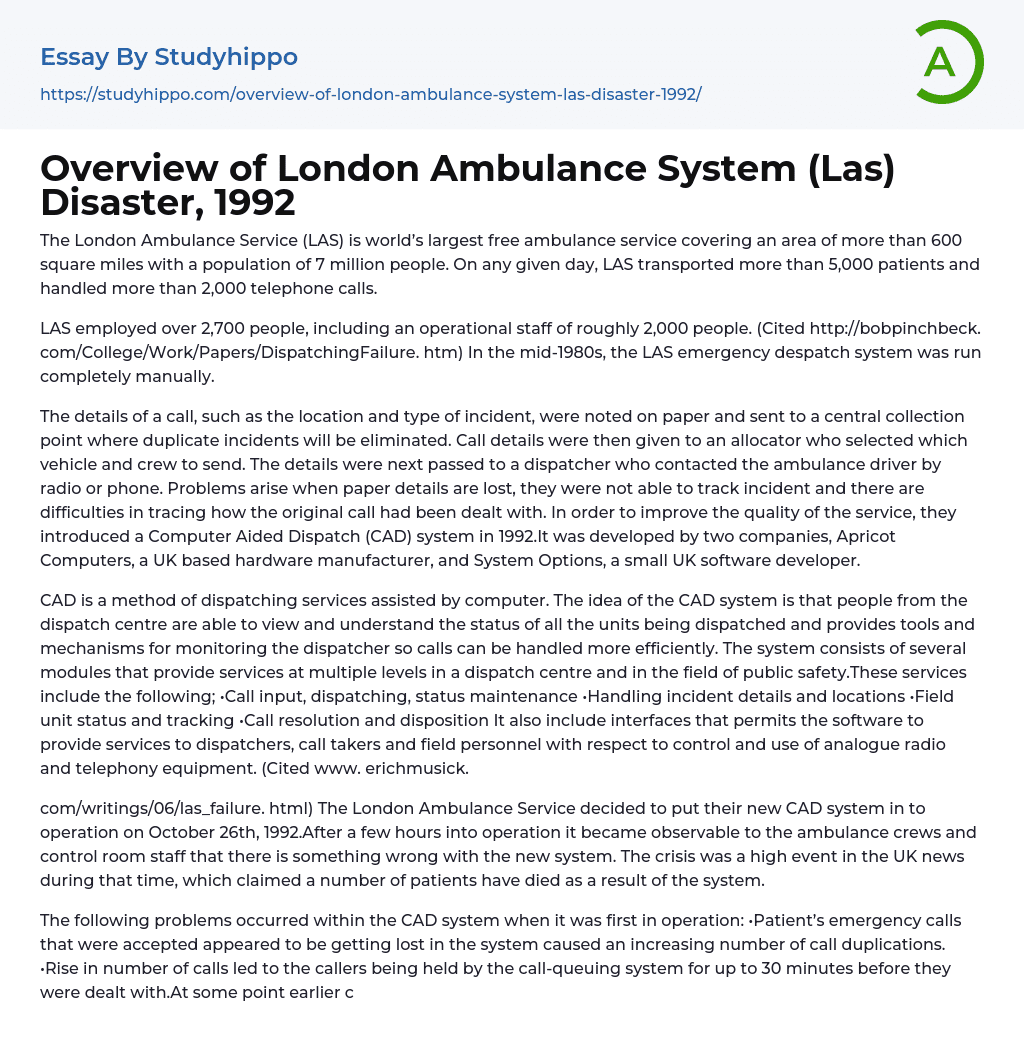

Overview of London Ambulance System (Las) Disaster, 1992 Essay Example
The London Ambulance Service (LAS) is world’s largest free ambulance service covering an area of more than 600 square miles with a population of 7 million people. On any given day, LAS transported more than 5,000 patients and handled more than 2,000 telephone calls.
LAS employed over 2,700 people, including an operational staff of roughly 2,000 people. (Cited http://bobpinchbeck. com/College/Work/Papers/DispatchingFailure. htm) In the mid-1980s, the LAS emergency despatch system was run completely manually.
The details of a call, such as the location and type of incident, were noted on paper and sent to a central collection point where duplicate incidents will be eliminated. Call details were then given to an allocator who selected which vehicle and crew to send. The details were next passed to a dispatcher who contacted the ambulance driv
...er by radio or phone. Problems arise when paper details are lost, they were not able to track incident and there are difficulties in tracing how the original call had been dealt with. In order to improve the quality of the service, they introduced a Computer Aided Dispatch (CAD) system in 1992.It was developed by two companies, Apricot Computers, a UK based hardware manufacturer, and System Options, a small UK software developer.
CAD is a method of dispatching services assisted by computer. The idea of the CAD system is that people from the dispatch centre are able to view and understand the status of all the units being dispatched and provides tools and mechanisms for monitoring the dispatcher so calls can be handled more efficiently. The system consists of several modules that provide services at multiple levels in a dispatch centre and in the fiel
of public safety.These services include the following; •Call input, dispatching, status maintenance •Handling incident details and locations •Field unit status and tracking •Call resolution and disposition It also include interfaces that permits the software to provide services to dispatchers, call takers and field personnel with respect to control and use of analogue radio and telephony equipment. (Cited www. erichmusick.
com/writings/06/las_failure. html) The London Ambulance Service decided to put their new CAD system in to operation on October 26th, 1992.After a few hours into operation it became observable to the ambulance crews and control room staff that there is something wrong with the new system. The crisis was a high event in the UK news during that time, which claimed a number of patients have died as a result of the system.
The following problems occurred within the CAD system when it was first in operation: •Patient’s emergency calls that were accepted appeared to be getting lost in the system caused an increasing number of call duplications. •Rise in number of calls led to the callers being held by the call-queuing system for up to 30 minutes before they were dealt with.At some point earlier calls were overwritten by newer emergency calls coming into the system, leaving a large number of unanswered calls which caused a number of exception messages. •The ambulance allocation system failed to recognize certain roads. Staffs had to revert to using a map and telephone to deal with ambulance dispatches, which ultimately led to more delays. •There was a communication failure between the ambulances and the system.
Ambulance either arrived late, did not arrive at all or arrive two at the same
time. (Cited www. comp. lancs. ac.
uk/computing/resources/IanS/SE7/CaseStudies/LondonAmbulance/LASFailure. pdf)
- Cars essays
- Bicycle essays
- Rms Titanic essays
- Renault essays
- Truck essays
- chrysler essays
- The city essays
- Racing essays
- Cloud Computing essays
- Computer Science essays
- Consumer Electronics essays
- Data Analysis essays
- Electronics essays
- engineering essays
- Enterprise Technology essays
- Hardware essays
- Impact of Technology essays
- Information Age essays
- Information Technology essays
- Modern Technology essays
- Operating Systems essays
- people search essays
- Robot essays
- Athens essays
- Belgium essays
- Berlin essays
- British essays
- England essays
- Germany essays
- Great britain essays
- Greece essays
- Ireland essays
- Italy essays
- London essays
- Paris essays
- Pompeii essays
- Rome essays
- Russia essays
- Spain essays
- United Kingdom essays
- Network Topology essays
- Telecommunication essays
- Telecommunications essays
- Adaptation essays
- Adventure essays
- Adversity essays
- Aging essays
- Alcohol essays
- Barbie Doll essays
- Beauty essays



